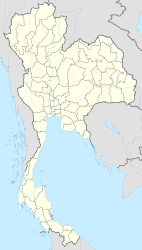Lampang
|
ลำปาง Lampang |
||
|---|---|---|
|
|
||
| Coordinates | 18 ° 17 ′ N , 99 ° 30 ′ E | |
| Symbols | ||
|
||
| Basic data | ||
| Country | Thailand | |
| Lampang | ||
| ISO 3166-2 | TH-52 | |
| Residents | 55,852 (2012) | |
Lampang ( Thai ลำปาง , old name Nakhon Khelang) is a city ( เทศบาล นคร ลำปาง ) in the Thai province of Lampang . It is the capital of Mueang Lampang County ( Amphoe ) and the capital of Lampang Province. The Lampang Province is located in the northern region of Thailand .
The city of Lampang has 55,852 inhabitants. (As of 2012) However, this only refers to the core city. This also has a densely populated surrounding area. In the western and southern suburbs, which were combined to Thesaban Mueang Khelang Nakhon (after the historical name Lampangs), live another 60,740, in the northeast bordering Thesaban Mueang Phichai 12,850 inhabitants.
geography
Lampang is about 80 kilometers southeast of Chiang Mai in a wide plain of the Mae Nam Wang , the distance to the capital Bangkok is about 500 kilometers. The city is surrounded by forests and a picturesque mountain landscape, the Khuntan Mountains in the west and the Pi-Pan-Num Mountains in the east.
climate
Lampang has a relatively dry climate. "Winter" begins after the last monsoon showers in November and lasts until March. Cold air masses from Siberia sometimes (but relatively rarely) lead to night temperatures below 10 degrees Celsius. Winter is usually very dry, sunny, clear and quite pleasant by day, cool and often foggy by night.
Summer usually lasts from March to June. In April, temperatures rise to 40 degrees Celsius. In the afternoon there are more frequent storms and rain showers.
The rainy season starts in June and lasts until November. Lampang is outside of the major monsoon winds and therefore does not suffer from the major floods that have plagued Chiang Mai in recent years.
economy
traffic
Airport
railroad
Lampang has a station of the Thai state railway on the north runway , the Bangkok with Chiang Mai connects.
Educational institutions
history
Lampang was the capital of a Mon principality of the same name , which was founded in the 7th century. In the 11th century it came to the Khmer Empire, under King Mangrai to Lan Na . In the 16th century, the Burmese conquered the entire north of what is now Thailand, including Lampang. In the late 18th century, Nan Thip Chang murdered the local Burmese ruler at Wat Phrathat Lampang Luang and drove the Burmese out in an uprising. The successors Nan Thip Chang, known as the Chao Chet Ton ("the seven princes") became the rulers of the Lan Na cities until the Lan Na empires were annexed to Siam ( Thailand ) under King Chulalongkorn ( Rama V ) .
Attractions
Although Lampang can be easily reached by train, bus or plane, it has been spared the mass tourism that has changed the character of Chiang Mai or Chiang Rai so much. Tourists usually only come for a short stopover and visit one of the well-known Buddhist temples ( wat ) .
- Wat Phra Kaeo Don Tao - one of the most revered temples in Thailand, built from 1680, beautiful wood carvings in Burmese style and a clay elephant, which is supposed to remind us that the famous Emerald Buddha was once kept here in the 15th century.
- Wat Sri Bunrueang and Wat Pa Fang are two sprawling Burmese-style temples that were expanded by wealthy Thais in the late 19th century.
- Wat Phra That Chedi Sao - the Temple of the Twenty Chedis .
- The station building in the municipality of Phichai was designed and built between 1906 and 1912 by the German architect Karl Döhring .
Personalities
- Korraphat Nareechan (* 1997), football player
Web links
- Lampang City Council website (in Thai)
- City map of Lampang (names in English and Thai) [Accessed December 3, 2013]
Individual evidence
- ↑ Department of Provincial Administration : As of 2012 (in Thai)




